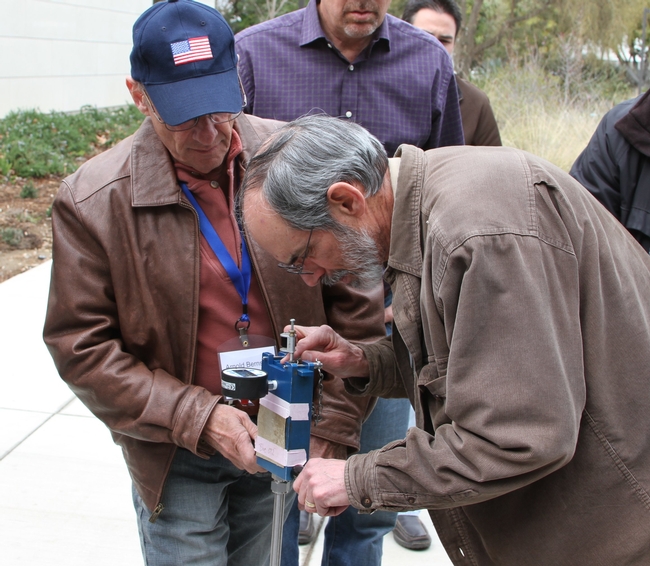
“The website helps growers interpret what their trees and vines are trying to tell them,” said Brooke Jacobs, associate director of the Fruit and Nut Center. “It lets them easily see whether their plants' water-stress levels are normal, or whether they are starting to get thirsty.”
Good water management is vital to crop production, as growers struggle to conserve water, control weeds and make sure nutrients like nitrogen don't get washed away from the orchards they feed. Most growers irrigate when it's hot outside and the soil is dry, which can lead to overwatering.
“Just because the soil is dry, doesn't mean plants are suffering,” explained UC Davis plant physiology professor Ken Shackel, whose research led to routine use of pressure chambers to measure plant water stress in the early 1990s.
Pressure chambers directly measure a plant's water needs by gauging how hard the plant is working to pull moisture from the soil. Researchers and industry leaders promote the use of pressure chambers, and growers who use them often sing their praises.
“Pressure chambers are a fantastic tool for making sure you're watering your trees only when they need it,” said Jerry Sneed, field representative for Crain Ranch, a walnut producing and processing operation in Los Molinas, Calif. “I have total faith in them. They've never steered us wrong.”
“They're great,” agreed Rob Baker, ranch manager at Paramount Farming Co. in Bakersfield, Calif., the world's largest grower and processor of almonds and pistachios. “We've been using them for about 20 years, and we believe they provide the most accurate reading for when to irrigate.”
Still, less than one-third of California growers use pressure chambers to schedule irrigation. As the drought wears on, more growers are making the $1,200 to $3,000 investment in pressure chambers, but some of those new users are having trouble interpreting the water-stress readings.
“All plants will register some level of stress, even when they are fully watered and happy,” said Jacobs, who built the site — “Irrigation Scheduling Using Stem Water Potential Measurements” — along with Shackel and Charlie Turner at UC Davis Academic Technology Systems. “So it can be confusing if you don't know what is considered ‘normal' stress for your plant under similar conditions.”
That's where the website comes in.
As Shackel explained, “Measuring water stress, or what we call stem water potential, at midday is like taking a blood pressure reading during exercise. When the weather is hot and dry, it's normal for the plant to be working harder to pull water, even if the soil is wet. The website calculates stem water potential expected for a plant in wet soil, under the weather conditions for that day. We call that the ‘baseline' value.
“If your tree's stem water potential is close to the baseline value,” Shackel continued, “adding water to the soil won't change how your tree is feeling.”
Another thing: Baseline values vary among species because different plants can handle different levels of stress. “Normal” stress readings for almonds would be considered severe stress for grapes and deadly for walnuts.
To understand all the variables, UC Cooperative Extension advisors provide training and reference charts. This website provides an additional, interactive tool.
“When you enter the date, the time, and the closest weather station, you get a baseline water-stress reading for a similar crop under similar conditions,” Jacobs said. “It takes out all the guesswork, because you can see how thirsty your trees and vines are compared to those in fully wet-soil conditions.”
The new site is good news for growers like Bill Chandler, owner of Chandler Farms in Selma, Calif. He just purchased a pressure chamber to help manage irrigation on his 250 acres of nectarines, plums, grapes and almonds.
“I was always an old-fashioned guy who liked to go out with my shovel and test the dryness of the soil with my hands,” Chandler said. “But if a pressure chamber can improve water management, why not give it a try?”
The website currently provides baseline values for almonds, walnuts, prunes and grapes. With further research, baseline values for other crops may be developed, as well.
Want to see how a pressure chamber works? Here's a video link: http://www.youtube.com/watch?v=8G9DjQxFkkY
You can read more about how pressure chambers operate here: http://fruitsandnuts.ucdavis.edu/pressure_chamber/
The new website is located at this link: http://informatics.plantsciences.ucdavis.edu/Brooke_Jacobs/index.php
For more information, contact the UC Davis Fruit and Nut Research and Information Center at 530-754-9708 or fruitsandnuts@ucdavis.edu
Media contacts:
- Diane Nelson, UC Davis College of Agricultural and Environmental Sciences, 530-752-1969, denelson@ucdavis.edu
- Brooke Jacobs, UC Davis Fruit and Nut Research and Information Center, 530-754-9708, fruitsandnuts@ucdavis.edu